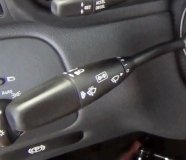Hi Mike. Welcome to the forum. First have a helper press the brake pedal while you watch the rear lights. If the failed one goes out while the right side turns on, the bad side has a bad ground. That could be corrosion in the socket, a broken wire, or a corroded splice for all of the sockets' ground wires. Ford likes to use a lot of wires tied together in one terminal that is bolted to the body sheet metal. That one should be ok since some of the bulbs are working.
Next, a good place to start is by removing all of the rear working bulbs from their sockets and look at just the bad one. If that bulb never turns on now, again, suspect a bad ground. Weird symptoms are caused by current going through the filaments of the bulbs on the other side when one socket has a bad ground. That's why removing the good-working bulbs can change the symptoms of the bad one.
If the bad bulb never lights up with the head lights off and the brake pedal pressed, look closely at the contacts in the socket. If your bulbs have the flat plastic bases, corrosion on the socket terminals is fairly common. Often they can be shined up with sandpaper. If your car still uses the bulbs with round brass bases, a poor connection can cause heat buildup that melts the round plastic disc holding the contacts. Pressing the bulb into the socket may identify that problem. The fix is to either replace the socket, or add a small bead of solder to the affected contact on the base of the bulb so it can reach down to the contact in the socket.
If you don't find anything obvious, you'll need to use a test light or an inexpensive digital voltmeter to see if there is voltage present to that socket. With the round brass base, one terminal will have 12 volts with the head lights turned on. The other one will have 12 volts with the brake pedal pressed or when the signals flash on. If you have two signal / brake lights per side and one of them works, you know the wiring from the turn signal switch to the rear is ok. If you only have one bulb per side, and voltage is missing to just the left brake / signal terminal, there could be a break in that wire all the way to the switch, or there could be a defective contact in the switch itself.
Caradiodoc
SPONSORED LINKS
Wednesday, September 8th, 2010 AT 12:05 AM




